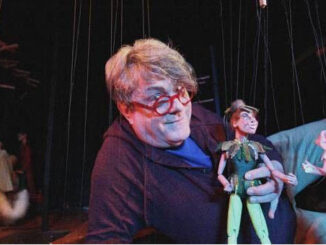 Director Lance Oppenheim’s exploration of some of the residents of The Villages lies visually and thematically at the intersection of Wes Anderson, Tim Burton and early Errol Morris. It combines the whimsical formalism of Anderson’s shot composition with Burton and Morris’s fascination for offbeat America to reveal a reality that might not lineup with the facade presented.
Director Lance Oppenheim’s exploration of some of the residents of The Villages lies visually and thematically at the intersection of Wes Anderson, Tim Burton and early Errol Morris. It combines the whimsical formalism of Anderson’s shot composition with Burton and Morris’s fascination for offbeat America to reveal a reality that might not lineup with the facade presented.
The Villages is a Florida planned retirement community that is advertised by its founder Harold Scwartz as the “Disneyland of retirement,” a place for seniors to come and live “everyday like you’re on vacation.” Founded in the early 1990s, it now boasts over 120,000 residents who spend their days playing sports or engaging in a number of other social activities in idyllic comfort. Or do they? And that’s the area that Oppenheim explores in the form of three separate stories about residents of The Villages.
Recently widowed Barbara is having a hard time adjusting to life as a single woman. She is not as lucky as many of the other residents of The Villages as she still needs to work to support herself. That isn’t enough to stave off the loneliness she feels, so she finds herself moving from singles groups to activities and classes like acting and dancing. But is her inability to make a new connection with someone a product of her lingering grief or something more fundamental with her?
At first, Reggie and Anne seem like a personification of the stereotypical “happy couple.” They have been married for 47 seemingly uneventful years. Now that they have moved to the Villages, Anne seems to spend her days out on the pickle-ball court which Reggie says he doesn’t resent, though he does wish he had someone to “pal around with.” Instead, Reggie has embarked on something of a spiritual quest complicated by signs of early dementia and a casual drug habit that leads to some run-ins with the local law.
But for all of Reggie and Anne’s problems, they’re nothing compared to Dennis Dean. Dean is only a resident of The Villages if you consider living out of your van parked overnight in various parking lots as a form of residency. Dennis is startlingly blunt about what he wants, an attractive rich widow he can charm into giving him a home and supporting him. It is easy to get the feeling from him that this has been pretty much how Dennis has lived his entire life, moving from relationship to relationship, sponging off of each for as long as he can. Dennis can be a fairly charming guy, but the women he targets have been around long enough to spot his type coming for them a mile away. As the film progresses we learn more things about Dennis that are terrible, but also do not come as much of a surprise.
Visually, Some Kind Of Heaven stands out somewhat in the sea of documentaries. In this age of compact cameras and digital photography, small budgeted documentaries like Some Kind Of Heaven usually shot with handheld cameras. But here, Oppenheim’s camera is distinctly locked down on a tripod the whole time, creating a sense of formalism to the composition that implies a static quality to life at the Villages. Oppenheim’s film is also presented in Academy ratio – the near square-like format that one normally associates with pre-widescreen films of the 1930s and 40s and pre-high definition television. With today’s audiences having been trained to see most things in wider aspect ratios, the use of the more restrictive picture here reinforces the idea that just maybe the residents of the Villages, and in particular the ones focused on here, are just walled in to their own, small worlds.
The real lesson here is that maybe there is no happily ever after, despite what a sales brochure may promise. We may think we have planned for every eventuality for our “Golden Years,” but the reality is that life continues to be as complicated as it always has been no matter what age one is, for better or worse.





